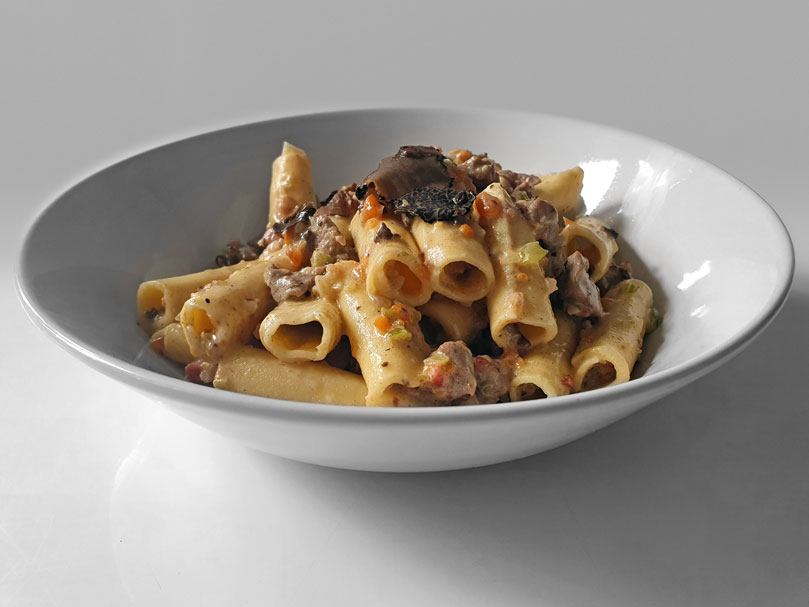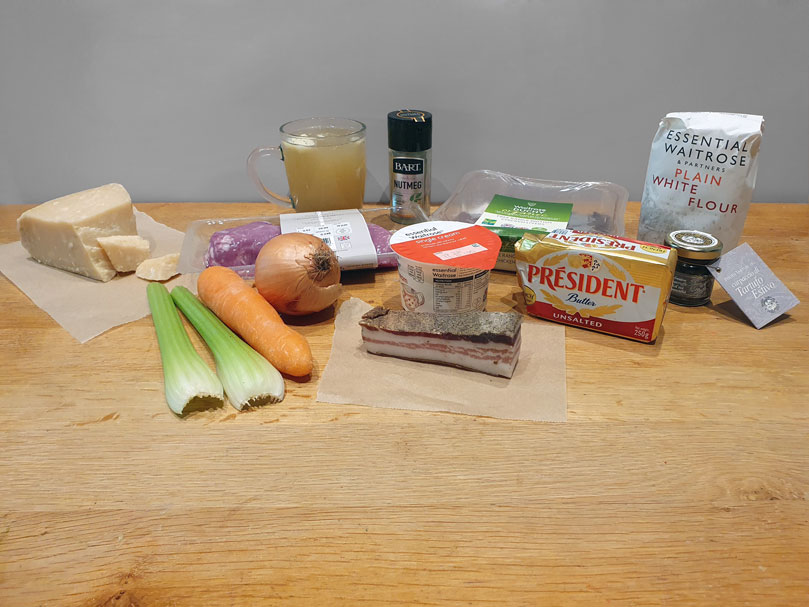
Pellegrino Artusi was an Italian businessman, author and food connoisseur. In 1881, and at the ripe old age of 71, he released his masterpiece:
The Kingdom of Italy had only formed two decades earlier and Artusi produced arguably its first ever cookbook. Rather than focussing on a single region the book covers dishes from across Italy.
It has been a hugely influential cookbook, but the reason it is important to us is that it shows the first printed record of pasta with a sauce referred to as “alla bolognese”.
Artusi’s cookbook is a really interesting read as he fills the pages with anecdotes and irrelevant chit chat about the people he’s met on his travels. The “Science of the Kitchen” is discussed in more depth than you might expect from a late 19th century septarian.
Artusi describes a bolognese which may not match your current expectations of the make up of this famous dish. Filet of finely sliced veal and pancetta are added to a butter fried soffitto of onions, carrots and celery. To this mix, he adds a small amount of brodo (stock), a pinch of flour, pepper and nutmeg.
Artusi is careful with his words, and at no point does he refer to this dish as a “ragù”. The cooking instructions point to a dish that, after mise en place, could be prepared in under 10 minutes.
Artusi’s bolognese contains no tomato, nor garlic, nor herbs. He does provide the optional extras of chicken livers and cream. I take him up on both these offers and would encourage the former but was left somewhat disappointed by the latter.
The most interesting perspective Artusi’s bolognese provides is towards the pasta (at the time “maccheroni” was a catch-all term for all pastas). In his recipe, Artusi dedicates over half his words to a discussion of the best choice and preparation of maccheroni.
He is quite clearly educating his fellow countrymen in the “al dente” pasta preparation norms we take for granted these days.
The pasta of choice for Artusi’s maccheroni alla bolognese is “half-sized horse teeth” or “denti di cavallo di mezzana”, which he insists are prepared with durum semolina flour.
The final result is a dish that is edible but not likely to take over the world. It ends up being a fairly bland meat and veg stir-fry, served over pasta. The century of tweaks and refinements that followed were required to bring bolognese up to its legendary global status.
Artusi can’t be blamed for the underwhelming feeling this dish leaves. As a keen diner on the main streets and down the back alleys of Bologna, Artusi would have eaten bologneses prepared similar to his recipe in many establishments. His recipe is just a reflection of what this dish represented at the time.
Click here now to read the full The Bolognese Story!
Ingredients
Serves 4.
The ragù can be refrigerated or frozen, the pasta can be stored in a cool place for a couple of days or refrigerated or frozen as pasta dough.
Bolognese (serves 4)
- 150g rose veal fillet
- 50g Italian pancetta
- 50g chicken livers
- 40g unsalted butter
- ¼ medium onion
- ½ medium carrot
- 2 celery stalks
- 1 tablespoon flour
- 100ml reserved brodo
- 100ml single cream
- ¼ teaspoon black pepper
- ¼ teaspoon nutmeg
- 50g parmesan cheese
- A few slices of black truffle carpaccio
- Salt
Denti di cavallo di mezzana grandezza (serves 2)
- 200g semolina flour
- 2 medium eggs
- Salt

Directions
Bolognese
- Soak the livers in a small pot of water for 30 minutes1.
- Finely slice the chicken livers with a mezzaluna2 and set aside.
- Slice the pancetta into lardons, then grind down to very small pieces with a mezzaluna and set aside.
- Slice the rose veal into small 2cm cubes and set aside
- Finely slice the onion, carrot and celery then combine and continue to slice with a mezzaluna and set aside.
- Place the butter in a large pan and cook on a high heat until it foams.
- Throw all the chopped ingredients into the pan and saute3 for 10-12 minutes.
- Reduce to a low heat and add the brodo and flour, stirring to incorporate. Continue to cook and allow some of the sauce to evaporate.
- Remove from heat and add the cream just before serving4.
Denti di cavallo di mezzana grandezza
- Create a semolina flour crater on a large wooden chopping board, or clear kitchen surface. Crack 2 eggs into the crater and whisk with a fork and add a pinch of salt.
- Once the egg mix begins to stiffen up, start kneading the dough with your hands1, pushing the dough ball into all the flour so that it is eventually part of the dough ball.
- After 5-10 minutes of kneading, wrap the dough ball in cling film and leave to rest in the fridge.
- Roll the ball into a single rectangular sheet with a rolling pin2.
- Pass the sheet through the pasta machine on the ‘0’ setting3, then pass the sheet through once more on the ‘1’ setting. Fold the dough in half lengthways and pass the dough back through the machine on the ‘0’ setting from the folded end. Repeat this 3 or 4 times4.
- Go through each of the settings of the pasta machine, from ‘0’ to ‘8’. The dough will lengthen each time and you may need to slice it in half to make it more manageable5.
- Cut the pasta sheets into long rectangles, about 2.5cm x 10cm. Using a rolling stick, roll the pasta lengthways applying gentle pressure to ensure the pasta remains intact. Repeat this process until all the pasta is converted to denti di cavallo.
- Place the denti di cavallo on a plate without any stacking. The denti di cavallo will naturally sag under its own weight. If you are drying the pasta before using it, roll the pieces of pasta occasionally so that they keep their shape.
- Bring a small pot of water to the boil and cook the pasta until al dente. If using the pasta fresh this will take only 60-90 seconds. If dried it could be up to 5 minutes.
Assembly
- Drain the pasta and mix thoroughly with the grated parmesan, being careful not to force the denti di cavallo to unravel.
- Combine the bolognese and continue to stir gentle until well mixed.
- Serve the pasta in narrow sided bowls and top with any remaining sauce.
- Finish off with three slices of truffle carpaccio per bowl and serve.
Cook’s notes
Bolognese
- You may decide to skip this step. The purpose is to wash some of the metallic taste off the surface of the livers, however, as this “bloodiness” is the effect we’re chasing in order to move away from the lean meat taste of veal.
- The livers will turn to mush.
- This is similar to making a stir-fry and I’d recommend a high heat and lots of pan movement.
- As discussed in the tasting notes, I’d recommend not adding cream.
- The better you get at this, the more likely you are to be working with metres of pasta sheets without the need to cut it down to size.
Denti di cavallo di mezzana grandezza
- Make sure your hands are well floured so the dough doesn’t stick to them. There’s no particular method required for kneading, just that the dough gets a lot of work.
- It is more important to have a perfect rectangle with variable thickness than a flat rectangle with rough edges, so fold the edges over on themselves to ensure a perfect (but lumpy) rectangle.
- You can ensure a smooth roll by cranking with one hand and guiding the dough to go through straight with the other hand.